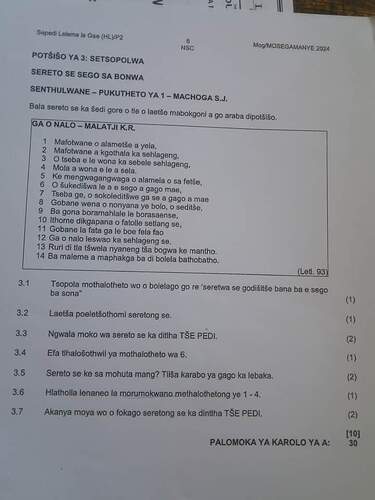Dimpho1 said
Answer:
The document provided seems to be a Sepedi language exam paper. It contains a poem titled “SERETO SE SEGO SA BONWA” written by MALATJI K.R. and several questions related to the poem. Below is a breakdown of the document:
Poem:
Here are the lines of the poem, translated roughly to English:
- Mafotwane is rooted at home,
- Mafotwane is hanging on summer,
- I’m also like summer,
- During summer, I am.
- When the winds blow, they blow elsewhere,
- Even sugarcane can’t be wherever you are,
- See how someone like you can’t be at home,
- How someone like you bores them,
- Those things transfer if they are from there.
- There, you find people when they are alone,
- There, with the companionship of others.
- That is the lesson of this summer.
- Indeed, evil ends in those months,
- The languages of the world that they speak to people.
Questions and Expected Responses:
-
3.1 Tsopola motalothetso wo o bolelago go re ‘seretwa se godimo ke bana ba e sego ba sona’
- Identify the phrase that is saying ‘the poem above is about children who are not the same.’.
-
3.2 Laetša poeletšothomi seretong se.
- Show repetition in this poem.
- Answer: The lines that repeat or have a similar structural pattern.
-
3.3 Ngwala moko wa sereto se ka dithla TŠE PEDI.
- Write the theme of this poem in TWO ways.
- Answer: The main theme could be the importance of heritage and the unchanging nature of traditions through generations (Interpretation can vary).
-
3.4 Efa tlhalosoṭhwi ya motalothetso.wa 6.
- Give an explanation of line 6.
- Answer: This line likely refers to the permanence or unchanging nature of customs or traditions symbolized by sugarcane.
-
3.5 Sereto se ke sa mohuta mang? Tliša karabo ya gago ka lebaka.
- What type of poem is this? Give a reason for your answer.
- Answer: This could be a cultural or traditional poem (Moroka gae type), focusing on customs and societal lessons.
-
3.6 Hlalosa liênaneo la morumokwano methalothoteng ye 1 - 4.
- Explain the structure or rhyme scheme in lines 1-4.
- Answer: The rhyme scheme and structural analysis could be based on the pattern seen in the first four lines.
-
3.7 Akanya moya wo o fokago seretong se ka dinthla TŠE PEDI.
- Imagine the spirit blowing into this poem in TWO ways.
- Answer: The spirit or essence of the poem could be one of respect for tradition and a meditation on cultural identity.
Final Answer:
These responses provide a thorough analysis of the poem and can be further elaborated based on the actual explanations required in the exam.
